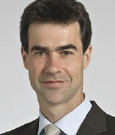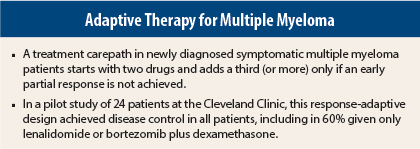For newly diagnosed multiple myeloma patients, Cleveland Clinic specialists believe two drugs may suffice for most patients, bucking the trend toward using triplets for all patients and reserving them for patients with insufficient response to two. They described a pilot study of their “carepath” at the 56th American Society of Hematology (ASH) Annual Meeting and Exposition.1
The carepath was described at the ASH meeting by two members of the Cleveland Clinic team: lead author Mayur Narkhede, MD, and senior investigator Frederic Reu, MD, who designed the algorithm.
Study Goals
“VRD (bortezomib [Velcade]/lenalidomide [Revlimid]/dexamethasone) is preferred by many centers due to higher response rates, although no survival advantage over Rd (lenalidomide/dexamethasone) has been shown. Since no test predicts who may experience harm from insufficient or excessive therapy, we designed a carepath that starts with two drugs but adapts treatment early to achieve uniform myeloma control,” Dr. Narkhede said.
While an overall survival advantage has not yet been observed, a higher risk of side effects and higher costs have clearly been demonstrated, they noted. In cytogenetically high-risk patients, use of three drugs for induction actually reduced overall survival in a retrospective analysis from Moffitt Cancer Center, they added.
Dr. Reu added, “Maybe we don’t need three drugs in all cases. In more than 60% of patients, we achieved disease control with two drugs, and the majority ultimately achieved a very good partial response or better,” he said.
“The problem with multiple myeloma research is that studies ignore the huge heterogeneity of this disease. No one adjusts the treatment plan according to anything that can be measured,” Dr. Reu noted. “Our pilot data show that this is generally safe and achieves disease control in all the patients tested so far.”
Carepath Details
The response-adaptive carepath was developed for newly diagnosed symptomatic patients with measurable disease and without associated amyloidosis, who were ineligible for or uninterested in trial participation. The carepath advises initial treatment with Rd or bortezomib/dexamethasone (VD), with therapy adjusted depending on the initial early response endpoints.
When patients fail to achieve reduction of M proteins to at least a minor response range after the first cycle or at least a partial response range after the second cycle of front-line treatment, clinicians add the other novel agent, then give another 1 to 2 cycles using the same parameters before stepwise addition of cyclophosphamide, and if these response endpoints are still not met after an additional 2 cycles, liposomal doxorubicin may also be given. The choice between Rd and VD is based on insurance coverage and status of the kidneys; patients with suspected cast nephropathy receive VD.
Dr. Narkhede said an important component of this carepath is frequent assessments. “We assessed response after each cycle. Although we want to control multiple myeloma with two drugs if possible, we also want to avoid disease progression, since it can cause irreversible organ damage or death. This is generally avoided in partial remission, the first goal of induction, after which consolidation with autologous stem cell transplant is considered in eligible patients.”
After transplant, patients entered maintenance with low-dose lenalidomide or every-other-week bortezomib. If they did not undergo transplant, either because they were thought to be ineligible or they decided against it, patients continued on the doublet that produced a partial response, and after 3 years, entered the single-agent maintenance phase. If three or more drugs were required for induction, patients continued for 1 year on that regimen, then switched to VRD for 2 years, then entered maintenance.
Initial Success With Doublet
In a pilot study of 24 patients, 15 received induction with a doublet, 6 received a triplet, and 3 received four drugs. Among the 24 patients, 17 received Rd initially and 7 received VD. Of the 17 on Rd, partial responses or better were observed in 12.
Of the seven VD-treated patients, three had at least a very good partial response. In this group, who were treated with doublets only, one patient who initially achieved a partial response had progressive disease after 6.5 months.
Response-adapted therapy allowed disease control with the Rd or VD doublet in about 60% of patients after a median follow-up of almost 11 months. Subsequent triplets controlled disease in another 30%, while 10% required a fourth drug.
“Disease was controlled predominantly with a doublet,” Dr. Narkhede said.
Response-adapted therapy also avoided disease progression during induction and, so far, also death during follow-up. “None of 24 patients progressed before reaching a partial remission, the main goal of response-adapted induction, after a median follow-up of 10 months,” he noted.
Adverse events included hospitalization in one patient, below-the-knee deep-vein thrombosis in two patients, and peripheral neuropathy in two patients (one was grade 3 but transient).
The authors concluded that compared to VRD for all patients, which is an emerging trend, doublets reduced the rate of peripheral neuropathy and the cost of treatment. They estimated that the savings for this small cohort exceeded $4,000 per cycle.
Looking Ahead
Overall survival will be the ultimate assessment of the utility of this approach, but the response assessments to date support the ongoing use of the carepath, the authors concluded.
Dr. Reu said he would not be surprised if the carepath suggested a survival advantage. “In the future we need to test if this might translate into better overall survival. Maybe we are not causing drug resistance as fast as if we start off with three drugs.” ■
Disclosure: Dr. Reu has received research funding from Celgene, Novartis, and Millennium/Takeda, has been a consultant for Millennium/Takeda, and a member of the speakers bureau for Onyx. Dr. Narkhede reported no potential conflicts of interest.
Reference
1. Narkhede M, Valent J, Cummings C, et al: Results of an upfront myeloma carepath pilot with response-adapted therapy. 2014 ASH Annual Meeting. Abstract 2620. Presented December 7, 2014.



